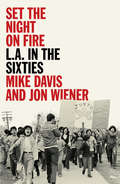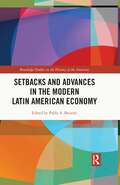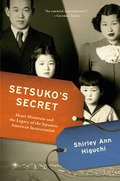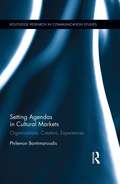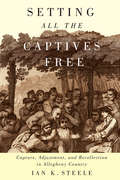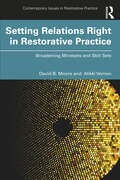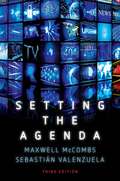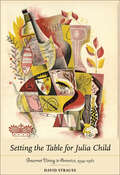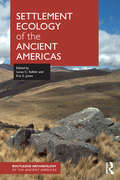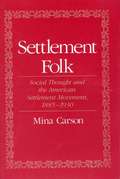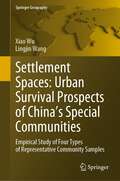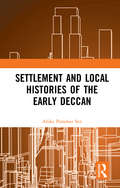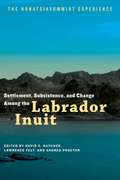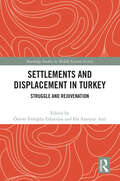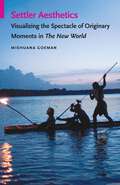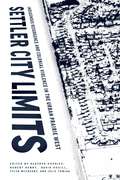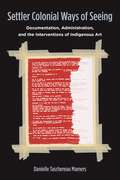- Table View
- List View
Set Fear on Fire: The Feminist Call That Set the Americas Ablaze
by LasTesisA fiery feminist manifesto from the Chilean performance collective who led the rallying cry for today's mass feminist movement across South AmericaAfter the feminist art collective LASTESIS created their performance &“A Rapist in Your Path&” in their native Chile, it went viral across the globe, becoming the anthem of the grassroots feminist movements in South America and around the world. This is their manifesto, an angry, unrepentant tour-de-force that moves through rage, femicide, abortion, homophobia, feminist art, and the oppression of the state to argue for a feminist world based on collective struggle and a visionary political art.Translated by Camila Valle.
Set the Night on Fire: L.A. in the Sixties
by Mike Davis Jon WienerA magisterial, riveting movement history of Los Angeles in the SixtiesLos Angeles in the sixties was a hotbed of political and social upheaval. The city was a launchpad for Black Power—where Malcolm X and Angela Davis first came to prominence and the Watts uprising shook the nation. The city was home to the Chicano Blowouts and Chicano Moratorium, as well as being the birthplace of &“Asian American&” as a political identity. It was a locus of the antiwar movement, gay liberation movement, and women&’s movement, and, of course, the capital of California counterculture. Mike Davis and Jon Wiener provide the first comprehensive movement history of L.A. in the sixties, drawing on extensive archival research and dozens of interviews with principal figures, as well as the authors&’ storied personal histories as activists. Following on from Davis&’s awardwinning L.A. history, City of Quartz, Set the Night on Fire is a historical tour de force, delivered in scintillating and fiercely beautiful prose.
Set the World on Fire: Black Nationalist Women and the Global Struggle for Freedom (Politics and Culture in Modern America)
by Keisha N. BlainIn 1932, Mittie Maude Lena Gordon spoke to a crowd of black Chicagoans at the old Jack Johnson boxing ring, rallying their support for emigration to West Africa. In 1937, Celia Jane Allen traveled to Jim Crow Mississippi to organize rural black workers around black nationalist causes. In the late 1940s, from her home in Kingston, Jamaica, Amy Jacques Garvey launched an extensive letter-writing campaign to defend the Greater Liberia Bill, which would relocate 13 million black Americans to West Africa.Gordon, Allen, and Jacques Garvey—as well as Maymie De Mena, Ethel Collins, Amy Ashwood, and Ethel Waddell—are part of an overlooked and understudied group of black women who take center stage in Set the World on Fire, the first book to examine how black nationalist women engaged in national and global politics from the early twentieth century to the 1960s. Historians of the era generally portray the period between the Garvey movement of the 1920s and the Black Power movement of the 1960s as one of declining black nationalist activism, but Keisha N. Blain reframes the Great Depression, World War II, and the early Cold War as significant eras of black nationalist—and particularly, black nationalist women's—ferment.In Chicago, Harlem, and the Mississippi Delta, from Britain to Jamaica, these women built alliances with people of color around the globe, agitating for the rights and liberation of black people in the United States and across the African diaspora. As pragmatic activists, they employed multiple protest strategies and tactics, combined numerous religious and political ideologies, and forged unlikely alliances in their struggles for freedom. Drawing on a variety of previously untapped sources, including newspapers, government records, songs, and poetry, Set the World on Fire highlights the flexibility, adaptability, and experimentation of black women leaders who demanded equal recognition and participation in global civil society.
Set to See Us Fail: Debating Inequalities in the Child Welfare System of New York (Anthropology at Work #3)
by Viola CastellanoExamining the interaction between families and professionals in the child welfare system of New York, this book focuses on how inequalities are reproduced, measured, managed, and contested. The book describes how state institutions and neoliberal governance police the groups which are most represented in the child welfare system, including low income, female-headed families living in racialized neighborhoods. The book also shows how these forms of policing produce unstable terrains, and give rise to contestation among families, communities, and professionals. It questions and re-thinks how state welfare and protection is administered.
Set-Theoretic Methods for the Social Sciences
by Carsten Q. Schneider Claudius WagemannQualitative Comparative Analysis (QCA) and other set-theoretic methods distinguish themselves from other approaches to the study of social phenomena by using sets and the search for set relations. In virtually all social science fields, statements about social phenomena can be framed in terms of set relations, and using set-theoretic methods to investigate these statements is therefore highly valuable. This book guides readers through the basic principles of set theory and then on to the applied practices of QCA. It provides a thorough understanding of basic and advanced issues in set-theoretic methods together with tricks of the trade, software handling and exercises. Most arguments are introduced using examples from existing research. The use of QCA is increasing rapidly and the application of set-theory is both fruitful and still widely misunderstood in current empirical comparative social research. This book provides an invaluable guide to these methods for researchers across the social sciences.
Setbacks and Advances in the Modern Latin American Economy
by Pablo A. BaisottiThis volume explores several notable themes related to the economy in Latin America and offers insightful historical perspectives to understand national, regional and global issues in the continent since the beginning of the 20th century to the present day. The collected essays focus on economic crises, the relationship of growth models to society and politics, the fluctuations of local economies and regional protests. Other aspects of consideration in this area include the evolution of integrated regional trading blocs, the informal economy, and the destruction of the productive potential that has had a serious social, cultural and environmental impact. The volume refuses to impose a traditional and uncritical linear historical narrative onto the reader and instead proposes an alternative interpretation of the past and its relation to the present.
Setsuko's Secret: Heart Mountain and the Legacy of the Japanese American Incarceration
by Shirley Ann HiguchiAs children, Shirley Ann Higuchi and her brothers knew Heart Mountain only as the place their parents met, imagining it as a great Stardust Ballroom in rural Wyoming. As they grew older, they would come to recognize the name as a source of great sadness and shame for their older family members, part of the generation of Japanese Americans forced into the hastily built concentration camp in the aftermath of Executive Order 9066. Only after a serious cancer diagnosis did Shirley's mother, Setsuko, share her vision for a museum at the site of the former camp, where she had been donating funds and volunteering in secret for many years. After Setsuko's death, Shirley skeptically accepted an invitation to visit the site, a journey that would forever change her life and introduce her to a part of her mother she never knew. Navigating the complicated terrain of the Japanese American experience, Shirley patched together Setsuko's story and came to understand the forces and generational trauma that shaped her own life. Moving seamlessly between family and communal history, Setsuko's Secret offers a clear window into the "camp life" that was rarely revealed to the children of the incarcerated. This volume powerfully insists that we reckon with the pain in our collective American past.
Setting Agendas in Cultural Markets: Organizations, Creators, Experiences (Routledge Research in Communication Studies)
by Philemon BantimaroudisThis book draws on agenda setting theory to examine how cultural organizations relate to media in order to increase their visibility, valence, and eventually build their public image. Most organizations have a keen interest in their symbolic presence, as their media visibility influences public knowledge, perceptions and even behaviors. Diminished public funding, in combination with the global proliferation of cultural entities, creates a competitive environment, leading to a transformation of cultural industries. In the book, several questions are under scrutiny: How do cultural organizations acquire symbolic significance? How do they become prominent in media content? Which mechanisms and processes should be examined by cultural managers as they set out to achieve salience? Is there a relationship between media and public salience? In other words, if an organization becomes symbolically prominent, in what ways is the public influenced, both in terms of perceptions as well as behaviors?
Setting All the Captives Free: Capture, Adjustment, and Recollection in Allegheny Country (McGill-Queen's Indigenous and Northern Studies #154)
by Ian K. SteeleAmong the many upheavals in North America caused by the French and Indian War was a commonplace practice that affected the lives of thousands of men, women, and children: being taken captive by rival forces. Most previous studies of captivity in early America are content to generalize from a small selection of sources, often centuries apart. In Setting All the Captives Free, Ian Steele presents, from a mountain of data, the differences rather than generalities as well as how these differences show the variety of circumstances that affected captives’ experiences. The product of a herculean effort to identify and analyze the captives taken on the Allegheny frontier during the era of the French and Indian War, Setting All the Captives Free is the most complete study of this topic. Steele explores genuine, doctored, and fictitious accounts in an innovative challenge to many prevailing assumptions and arguments, revealing that Indians demonstrated humanity and compassion by continuing to take numerous captives when their opponents took none, by adopting and converting captives into kin during the war, and by returning captives even though doing so was a humiliating act that betrayed their societies' values. A fascinating and comprehensive work by an acclaimed scholar, Setting All the Captives Free takes the study of the French and Indian War in America to an exciting new level.
Setting Love in Order: Hope and Healing for the Homosexual
by Mario BergnerMario Bergner tells the story of his journey through life as a gay man in search of spiritual healing and acceptance from God. He shares the hope, questions, and truths he learned along the way. He shows how he came to know God and his understanding of the Bible. He believes that God loves everyone whether they are gay or straight and that God can restore and redeem anyone who seeks Him.
Setting Relations Right in Restorative Practice: Broadening Mindsets and Skill Sets (Contemporary Issues in Restorative Practice)
by David B. Moore Alikki VernonSetting Relations Right in Restorative Practice is a practical guide to using restorative processes, both in justice systems, to provide a healing response to harm, and in broader community contexts, to help people co-exist peacefully. Restorative processes can help to establish, maintain, deepen, and repair relationships, and to neutralise the conflict associated with negative relationships. The result is less conflict within people, between people, and between groups, and increasing individual and community wellbeing. These complex goals can be distilled to the single principle of setting relations right. The authors distil lessons from their decades of work at the frontline of restorative innovation. They outline an accurate, accessible theory that informs a restorative mindset, and describe in detail the corresponding skill set. Succinct, engaging case studies include refinements to existing programs in justice systems. Other case studies include the innovations of restorative responses to institutional abuse and to family violence and sexual harm, initiatives to increase psychological safety in schools and workplaces, and programs that support restorative ways-of-working across whole cities or regions. By applying elements from successful programs, practitioners can realise the broader reforming potential of restorative practice. This book is essential reading for restorative practitioners, administrators, and policymakers, for students and researchers – indeed, for anyone interested in the power and potential of restorative practice and other forms of deliberative decision-making.
Setting the Agenda: Mass Media and Public Opinion (Routledge Communication Ser.)
by Maxwell McCombs Sebastian ValenzuelaNews media strongly influence how we picture public affairs across the world, playing a significant and sometimes controversial role in determining which topics are at the centre of public attention and action. Setting the Agenda, first published in 2004, has become the go-to textbook on this crucial topic. In this timely third edition, Maxwell McCombs – a pioneer of agenda-setting research – and Sebastián Valenzuela – a senior scholar of agenda setting in Latin America – have expanded and updated the book for a new generation of students. In describing the media's influence on what we think about and how we think about it, Setting the Agenda also examines the sources of media agendas, the psychological explanation for their impact on the public agenda, and their consequences for attitudes, opinions and behaviours. New to this edition is a discussion of agenda setting in the widened media landscape, including a full chapter on network agenda setting and a lengthened presentation on agenda melding. The book also contains expanded material on social media and the role of agenda setting beyond the realm of public affairs, as well as a foreword from Donald L. Shaw and David H. Weaver, the co-founders of agenda-setting theory. This exciting new edition is an invaluable source for students of media, communications and politics, as well as those interested in the role of news in shaping and directing public opinion.
Setting the Table for Julia Child: Gourmet Dining in America, 1934–1961
by David StraussBefore Julia Child’s warbling voice and towering figure burst into America’s homes, a gourmet food movement was already sweeping the nation. Setting the Table for Julia Child considers how the tastes and techniques cultivated at dining clubs and in the pages of Gourmet magazine helped prepare many affluent Americans for Child’s lessons in French cooking. David Strauss argues that Americans’ appetite for haute cuisine had been growing ever since the repeal of Prohibition. Dazzled by visions of the good life presented in luxury lifestyle magazines and by the practices of the upper class, who adopted European taste and fashion, upper-middle-class Americans increasingly populated the gourmet movement. In the process, they came to appreciate the cuisine created by France's greatest chef, Auguste Escoffier. Strauss’s impressive archival research illuminates themes—gender, class, consumerism, and national identity—that influenced the course of gourmet dining in America. He also points out how the work of painters and fine printers—reproduced here—called attention to the aesthetic of dining, a vision that heightened one’s anticipation of a gratifying experience. In the midst of this burgeoning gourmet food movement Child found her niche. The movement may have introduced affluent Americans to the pleasure of French cuisine years before Julia Child, but it was Julia’s lessons that expanded the audience for gourmet dining and turned lovers of French cuisine into cooks.
Settlement Ecology of the Ancient Americas (Routledge Archaeology of the Ancient Americas)
by Lucas C. Kellett and Eric E. JonesIn this exciting new volume several leading researchers use settlement ecology, an emerging approach to the study of archaeological settlements, to examine the spatial arrangement of prehistoric settlement patterns across the Americas. Positioned at the intersection of geography, human ecology, anthropology, economics and archaeology, this diverse collection showcases successful applications of the settlement ecology approach in archaeological studies and also discusses associated techniques such as GIS, remote sensing and statistical and modeling applications. Using these methodological advancements the contributors investigate the specific social, cultural and environmental factors which mediated the placement and arrangement of different sites. Of particular relevance to scholars of landscape and settlement archaeology, Settlement Ecology of the Ancient Americas provides fresh insights not only into past societies, but also present and future populations in a rapidly changing world.
Settlement Folk: Social Thought and the American Settlement Movement, 1885-1930
by Mina CarsonIn 1889 Jane Addams founded Hull-House, a social settlement on Chicago's South Side which soon became world-famous as a center for activism. Other settlements were established in New York, Boston, Philadelphia, and many smaller cities. Each had its own character and mission, but in general the settlements were centers of culture and places of help in a city's poorest neighborhoods. Educated young women and men became "residents" of the settlement houses in order to make life better for their "neighbors." In this meticulously researched book Carson traces the history of the American settlement movement through its first four decades, focusing on the work of such key founders and early workers as Jane Addams, Lillian Wald, Robert Woods, and Albert Kennedy.
Settlement Spaces: Empirical Study of Four Types of Representative Community Samples (Springer Geography)
by Xiao Wu Lingjin WangThis book examines the settlement space of special communities in China on the community scale from an interdisciplinary approach that combines perspectives from urban planning and sociology. Using the framework of integration response, it theoretically and empirically explores the approaches these communities adopt to survive and evolve. Empirically, this discussion centers on four particular groups, namely international students, land-lost peasants, ethnic minorities, and migrant workers, and offers an analysis of their settlement spaces from different perspectives. Theoretically, this study optimizes the logic of one-way integration as used in classical theories. By constructing a two-way linkage in the theoretical framework of integration response, it provides a multi-scenario interpretation and summary of the laws of survival and evolution that govern the urban settlements of special communities in China. This study conforms to the major transformations that China has undergone in the concepts, models, and orientation of its development since the 18th National Congress of the Chinese Communist Party. Furthermore, it renders profound research value and bears practical significance for the adjustment and management of urban spatial patterns in China, social care for marginalized groups, and the construction of a harmonious and moderately prosperous society. This study provides valuable reference for educators, researchers, and management personnel across various fields, including urban planning, geography, and sociology.
Settlement and Local Histories of the Early Deccan
by Aloka Parasher SenThis book is a detailed account of the multi-faceted history of the Deccan. Beginning with its historical foundations it goes on to delineate how it is the key to understanding its social, economic, political and ideological evolution.Containing nine essays, this volume attempts to look at regional history from the perspective of given localities that provides the many facets of early Deccani society and culture. Hitherto, this was mainly articulated in terms of the broad categories of language and religion in the many historical studies of present-day linguistic states. In focussing on local spatial contexts as the primary layer of historical reality, the book has relied on multiple sources of information, largely extant archaeological material while also drawing information from inscriptions, textual material and oral memory. The book also reflects on the important events of various periods by placing them as part of larger social and economic processes emanating from the local.The essays in this collection have been presented thematically moving from general issues discussed in Part I to the more particular in Part II and finally, to reflect on the multiplicity and simultaneity of different kinds of processes in a constant state of negotiation, in Part III. The historical sensibilities of people in various locations right from Kotalingala and Dhulikatta to Phanigiri, Patancheru, Kondapur and Nanakramguda and from Thotlakonda to Nagarjunakonda, Amaravati, Vaddamanu and Shravan Belgola have been recounted. Please note: Taylor & Francis does not sell or distribute the Hardback in India, Pakistan, Nepal, Bhutan, Bangladesh and Sri Lanka.
Settlement, Subsistence, and Change Among the Labrador Inuit: The Nunatsiavummiut Experience
by David C. Natcher Lawrence Felt Andrea ProcterOn January 22, 2005, Inuit from communities throughout northern and central Labrador gathered in a school gymnasium to witness the signing of the Labrador Inuit Land Claim Agreement and to celebrate the long-awaited creation of their own regional self-government of Nunatsiavut.This historic agreement defined the Labrador Inuit settlement area, beneficiary enrollment criteria, and Inuit governance and ownership rights. Settlement, Subsistence, and Change Among the Labrador Inuit explores how these boundaries – around land, around people, and around the right to self-govern – reflect the complex history of the region, of Labrador Inuit identity, and the role of migration and settlement patterns in regional politics. Comprised of twelve essays, the book examines the way of life and cultural survival of this unique indigenous population, including: household structure, social economy of wildfood production, forced relocations and land claims, subsistence and settlement patterns, and contemporary issues around climate change, urban planning, and self-government.
Settlement, society and cognition in human evolution
by Francis Wenban-Smith Fiona Coward Robert Hosfield Matt PopeThis volume provides a landscape narrative of early hominin evolution, linking conventional material and geographic aspects of the early archaeological record with wider and more elusive social, cognitive and symbolic landscapes. It seeks to move beyond a limiting notion of early hominin culture and behavior as dictated solely by the environment to present the early hominin world as the outcome of a dynamic dialogue between the physical environment and its perception and habitation by active agents. This international group of contributors presents theoretically informed yet empirically based perspectives on hominin and human landscapes.
Settlements and Displacement in Turkey: Struggle and Rejuvenation (Routledge Studies in Middle Eastern Society)
by Özlem Erdoğdu Erkarslan Ela Alanyalı AralThis book explores the complex relationship between urban space and displacement in Turkey. It evaluates how the displacement of people and cultures has affected the spatiotemporal landscapes of the nation at different periods of contemporary Turkey, with an emphasis on various narratives of the relocating population and their relationship to the environment. Contemporary cities are constantly changing due to the movement of people from different regions, resulting in shifting population patterns globally. Understanding displacement and its effects on space are crucial in studying this phenomenon, as it not only involves the physical relocation of individuals, but also the transfer of cultural practices within a condensed timeframe. This process changes the destination of settlements irreversibly. This book takes a methodological approach and disclinary approach, examining the migration and displacement of people and its effects upon art, architecture, culture and politics in Turkish cities. This book will be of interest to students and scholars interested in migration and its effects on cities, urban planning and architecture.
Settler Aesthetics: Visualizing the Spectacle of Originary Moments in The New World (Indigenous Films)
by Mishuana GoemanIn Settler Aesthetics, an analysis of renowned director Terrence Malick&’s 2005 film, The New World, Mishuana Goeman examines the continuity of imperialist exceptionalism and settler-colonial aesthetics. The story of Pocahontas has thrived for centuries as a cover for settler-colonial erasure, destruction, and violence against Native peoples, and Native women in particular. Since the romanticized story of the encounter and relationship between Pocahontas and Captain John Smith was first published, it has imprinted a whitewashed historical memory into the minds of Americans. As one of the most enduring tropes of imperialist nostalgia in world history, Renaissance European invasions of Indigenous lands by settlers trades in a falsified &“civilizational discourse&” that has been a focus in literature for centuries and in films since their inception. Ironically, Malick himself was a symbol of the New Hollywood in his early career, but with The New World he created a film that serves as a buttress for racial capitalism in the Americas. Focusing on settler structures, the setup of regimes of power, sexual violence and the gendering of colonialism, and the sustainability of colonialism and empires, Goeman masterfully peels away the visual layers of settler logics in The New World, creating a language in Native American and Indigenous studies for interpreting visual media.
Settler City Limits: Indigenous Resurgence and Colonial Violence in the Urban Prairie West
by Robert Henry Heather Dorries David Hugill Tyler McCreary Julie TomiakWhile cities like Winnipeg, Minneapolis, Saskatoon, Rapid City, Edmonton, Missoula, Regina, and Tulsa are places where Indigenous marginalization has been most acute, they have also long been sites of Indigenous placemaking and resistance to settler colonialism. Although such cities have been denigrated as “ordinary” or banal in the broader urban literature, they are exceptional sites to study Indigenous resurgence. The urban centres of the continental plains have featured Indigenous housing and food co-operatives, social service agencies, and schools. The American Indian Movement initially developed in Minneapolis in 1968, and Idle No More emerged in Saskatoon in 2013. The editors and authors of Settler City Limits , both Indigenous and settler, address urban struggles involving Anishinaabek, Cree, Creek, Dakota, Flathead, Lakota, and Métis peoples. Collectively, these studies showcase how Indigenous people in the city resist ongoing processes of colonial dispossession and create spaces for themselves and their families. Working at intersections of Indigenous studies, settler colonial studies, urban studies, geography, and sociology, this book examines how the historical and political conditions of settler colonialism have shaped urban development in the Canadian Prairies and American Plains. Settler City Limits frames cities as Indigenous spaces and places, both in terms of the historical geographies of the regions in which they are embedded, and with respect to ongoing struggles for land, life, and self-determination.
Settler Colonial City: Racism and Inequity in Postwar Minneapolis
by David HugillRevealing the enduring link between settler colonization and the making of modern Minneapolis Colonial relations are often excluded from discussions of urban politics and are viewed instead as part of a regrettable past. In Settler Colonial City, David Hugill confronts this culture of organized forgetting by arguing that Minnesota&’s largest city is enduringly bound up with the power dynamics of settler-colonial politics. Examining several distinct Minneapolis sites, Settler Colonial City tracks how settler-colonial relations were articulated alongside substantial growth in the Twin Cities Indigenous community during the second half of the twentieth century—creating new geographies of racialized advantage. Studying the Phillips neighborhood of Minneapolis in the decades that followed the Second World War, Settler Colonial City demonstrates how colonial practices and mentalities shaped processes of urban reorganization, animated non-Indigenous &“advocacy research,&” informed a culture of racialized policing, and intertwined with a broader culture of American imperialism. It reveals how the actions, assumptions, and practices of non-Indigenous people in Minneapolis produced and enforced a racialized economy of power that directly contradicts the city&’s &“progressive&” reputation. Ultimately, Settler Colonial City argues that the hierarchical and racist political dynamics that characterized the city&’s prosperous beginnings are not exclusive to a bygone era but rather are central to a recalibrated settler-colonial politics that continues to shape contemporary cities across the United States.
Settler Colonial Sovereignty: Visions of Improvement and Indigenous Erasure
by Liam Midzain-GobinKnowledge production in the Anglosphere depends on the erasure of non-Western ways of knowing – especially ways of knowing oneself, the lands and waters, and the relationships between these entities. In settler colonial states those in power seldom question this erasure, despite the ongoing presence and power of Indigenous nations.In this groundbreaking work, Liam Midzain-Gobin illuminates how the logic of improvement animates this epistemological ignorance, both historically and currently. By creating a new world based on settler views, the settler state augments its own power. This way of thinking drives government actions and even influences how settlers and the state imagine what is possible. Examining knowledge production through governance processes, Settler Colonial Sovereignty studies three policy areas: First Nations reserve policy, land and resource monitoring frameworks, and the Indigenous Peoples Survey. Throughout, Midzain-Gobin shows how state sovereignty is never stable but continually being reaffirmed.Inspired by the interaction of Indigenous knowledge with cosmological assumptions to provide different understandings of our place in the world, Settler Colonial Sovereignty imagines how we might move past improvement as a basis for Indigenous-settler relations.
Settler Colonial Ways of Seeing: Documentation, Administration, and the Interventions of Indigenous Art
by Danielle Taschereau MamersAn innovative analysis of Indigenous strategies for overcoming the settler state.How do bureaucratic documents create and reproduce a state’s capacity to see? What kinds of worlds do documents help create? Further, how might such documentary practices and settler colonial ways of seeing be refused?Settler Colonial Ways of Seeing investigates how the Canadian state has used documents, lists, and databases to generate, make visible—and invisible—Indigenous identity. With an archive of legislative documents, registration forms, identity cards, and reports, Danielle Taschereau Mamers traces the political and media history of Indian status in Canada, demonstrating how paperwork has been used by the state to materialize identity categories in the service of colonial governance. Her analysis of bureaucratic artifacts is led by the interventions of Indigenous artists, including Robert Houle, Nadia Myre, Cheryl L’Hirondelle, and Rebecca Belmore. Bringing together media theories of documentation and the strategies of these artists, Settler Colonial Ways of Seeing develops a method for identifying how bureaucratic documents mediate power relations as well as how those relations may be disobeyed and re-imagined.By integrating art-led inquiry with media theory and settler colonial studies approaches, Taschereau Mamers offers a political and media history of the documents that have reproduced Indian status. More importantly, she provides us with an innovative guide for using art as a method of theorizing decolonial political relations. This is a crucial book for any reader interested in the intersection of state archives, settler colonial studies, and visual culture in the context of Canada’s complex and violent relationship with Indigenous peoples.

